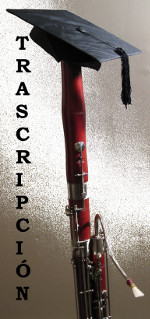Weissenborn Opus 8/2, Study #13 for advanced bassoon students. Comments include playing on the wind, flicking, and alternate fingerings. By Terry B. Ewell, Bassoon Digital Professor. BDP#121.
Weissenborn Opus 8/2, Estudio Avanzado #13. Comentarios acerca de
tocar sobre el aire, llaves de octava y digitaciones alternativas. Por
Terry B. Ewell, Profesor Digital de Fagot. Traducido por Germán
Martínez López. BDP#121.
TUTORIAL
Welcome, this is Terry Ewell.
1. Weissenborn study #13 starts with a tongued run that is best played “on the wind.” By this I mean that the player should provide the same air support and phrase shaping as if the notes were slurred. Avoid excessive jaw movements, if you can. Instead shape the length of the notes with the tongue. For further information on “playing on the wind” please see Bassoon Digital Professor video #56.
1.Bienvenidos. El estudio nº13 de Weissenborn empieza con un pasaje de notas picadas que es mejor tocar “sobre el aire”. Con esto quiero decir que hay que tocar las notas con el mismo soporte de aire y fraseo como si las notas estuviesen ligadas. Evitad excesivo movimiento de mandíbulas, si podéis. En su lugar, cambiad la duración de las notas con la lengua. Para más información sobre “tocar sobre el aire” echadle un ojo al vídeo BDP #56.
http://www.2reed.net/bdp/home.html#bdp56
2. Avoid pulsing on the dot of the dotted notes (dotted
quarter notes). Here is a way that students often play:
2.Evitad marcar el pulso en el puntillo de las notas con puntillo
(negras con puntillo). Esto es lo que los estudiantes suelen tocar:

3. Instead the melody line shouldn’t be interrupted with
these extra accents on the dots of dotted notes.
3. En su lugar, la melodía no debería ser
interrumpida con esos acentos extra en los puntillos de las notas con puntillo.
4. There are common counting errors that students make in this study.
Be sure that the quarter note followed by the eighth rest in line one
are accurate. Also don’t add a beat after the A4 at the end
of the second line.
4.Los estudiantes cometen comúnmente ciertos errores de medida en este estudio. Aseguráos de que medís bien la negra seguida por el silencio de corchea en la primera línea. Tampoco añadáis un pulso después del La4 al final de la segunda linea.


5. I use alternate fingerings to help perform the sixteenth notes in
line 3. Normally I play G4 with the whisper (piano) key down. Here I
leave it off to move quickly to the left hand only fingering for A4.
5. Utilizo posiciones alternativas para que las semicorcheas de la
tercera línea sean más fáciles. Normalmente toco
Sol 4 con la llave del oído. Aquí no la cojo para moverme
rápidamente a la posición de La 4.

6. By the way you can view my standard fingerings at:
6.Por cierto, podéis ver digitaciones estándar en:
http://www.2reed.net/EwellArticles/BsnFingerings.pdf
7. The flick key “C” is best held down for repeated
tongued notes in a scale with A3, Bb3, B3, and C4. For instance, in
line 5 measures 4-6 you should have the C flick key depressed to
improve articulation as given here. Also this technique is employed in
the second measure of the study and elsewhere.
7. Es de utilidad mantener pulsada la llave de octava de Do para tocar notas picadas repetidas en una escala con La, Sib, Si y Do. Por ejemplo, en los compases 4-6 de la línea 5 deberíais pulsar la llave para mejorar la articulación que pone aquí. Esta técnica también se usa en el segundo compás del estudio y en algún sitio más.

8. I also use the flick key for slurred intervals of a third or more.
For instance, I flick the A3 at the end of line 6.
8. También uso las llaves de octava para intervalos ligados
de una tercera o más. Por ejemplo, para el La3 al final de la
sexta línea.
9. When Weissenborn gives a fermata in the music he implies a slight
rallentando or slowing down prior to the fermata. Sometimes he will
indicate this in the music and sometimes it will not be there.
9. Cuando Weissenborn escribe una fermata en la música,
utiliza también un pequeño rallentando antes de llegar a
la fermata. Algunas veces lo indicará en la música y a
veces no estará ahí.

REFLECTION REFLEXIÓN
10. Infinite striving to be the best is man's duty; it is its own reward. Everything else is in God's hands.—Mahatma Gandi
(accessed 19 Feb. 14, http://www.brainyquote.com/quotes/keywords/striving.html)
10. El esfuerzo infinito por ser el mejor es el
deber del hombre; es su propia recompensa. Todo lo demás está en manos de Dios.
- Mahatma Gandhi.
11. The Sochi 2014 Winter Olympics are concluding
just as I am writing this reflection. One thing that leads to the
excellence of the athletes is the outstanding quality of their coaches.
Many of the athletes travel to different regions of the USA or even
immigrate to other countries to be with the best coaches in their
events.
11. Los Juegos Olímpicos de 2014 están
concluyendo mientras escribo esta reflexión. Una de las cosas que permite la
excelencia de los atletas es la calidad de sus entrenadores. Muchos de los atletas
viajan a diversas regiones de EEUU o incluso viajan a otros países para estar
con los mejores entrenadores en sus eventos.
12. Estoy encantado de que estéis viendo este
vídeo y otros que he hecho. ¡Espero estar instruyéndoos bien! Pero estos vídeos
no son suficientes. Necesitáis buscar a los mejores para vuestros instrumentos
y, sí, siempre los mejores entrenadores y mentores para la vida. No os quedéis
en la mediocridad. El espíritu olímpico se caracteriza por ser el mejor
entrenando con los mejores.
